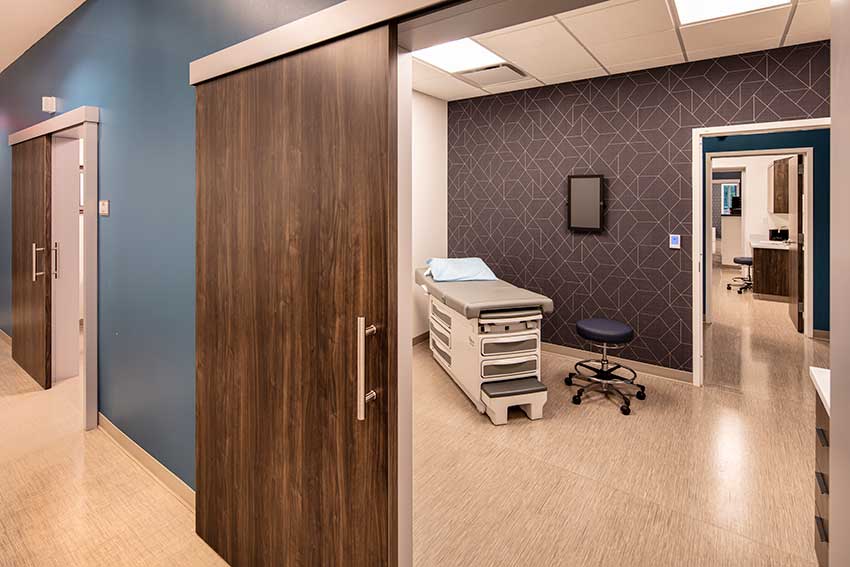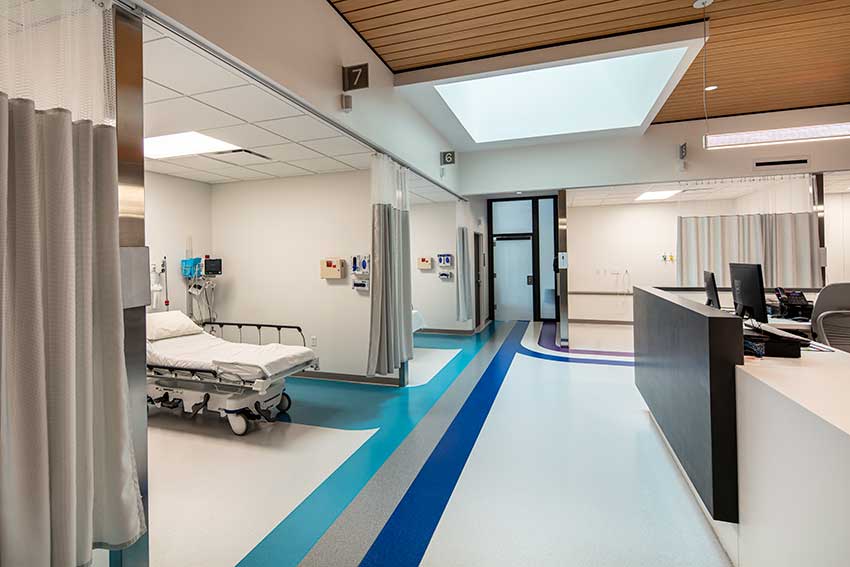Stone Wool Ceiling Tiles in Healthcare
Acoustic design requires an approach where absorption, isolation, and background sound performance work together without sacrificing aesthetic design. Three important components of acoustical performance are sound absorption, interior isolation, and mechanical (HVAC) noise control.
Unlike sound blocking, sound absorption is what happens when a material has the ability to absorb and dampen the sound. Softer materials, such as carpets, fabric panels, or perforated ceiling tiles, are most often used for this purpose. In a classroom full of kids, an open office with collaborating employees, or a medical facility where conversations need to be both private and intelligible, sound absorption is key. Sound absorption is calculated in terms of the NRC, which measures the amount of sound absorbed by ceiling panels or other materials. The higher the NRC, the higher the absorption.
Designing intentionally for a comfortable acoustic environment is important in supporting the safety, health, healing, and well-being for patients, staff, and visitors alike in any healthcare setting. An optimized acoustic environment reduces stress not only for the patient but also for doctors, nurses, and support staff. It can reduce errors and aid in good communication, which is essential in settings where accuracy is of the utmost importance.
Acoustics in healthcare settings also need to support speech privacy. Patients and their healthcare providers must be able to talk candidly about the patient’s condition, while adhering to confidentiality rules and HIPAA standards. A patient who feels their conversation may be overheard might end up withholding certain vital information or be reluctant to voice all their concerns. Maintaining speech privacy in healthcare settings encourages honest communication among patients, providers, and family members.
High-performance acoustical ceilings can improve patient and resident comfort and safety, while helping maintain caregiver and employee morale, focus, and productivity.
Several healthcare design guidelines emphasize the importance of acoustics in the design of healthcare environments. Published standards include Sound and Vibration Design Guidelines for Hospital and Healthcare Settings, HIPAA, Facilities Guidelines Institute FGI/ASHE Guidelines for Design and Construction for Health Care Facilities, LEED for Healthcare, and the Green Guide for Health Care.
Although we are focusing on health care environments, it is important to note that IEQ components are also essential to design in schools and offices, where speech intelligibility and productivity affect occupant health, safety, and well-being. In a big-picture view, it is worth thinking about how the indoor environmental quality of spaces in which we live, work, and play can set the stage for our long-term health. IEQ in healthcare spaces is important, but a holistic view of architecture can consider these other environments as spaces where preventative healthcare begins.
Building Resilience And Safety
The Urban Land Institute describes resilience for buildings as “the ability to prepare and plan for, absorb, recover from and more successfully adapt to adverse events.” Resilient buildings are created with resilient products that prove their ability to take on stressors and still absorb and retain their original state—just like how elastic returns back to form after being stretched.
Stone wool acoustical ceilings are durable, which is a quality that supports building resilience. Some of its durable aspects—such as having a resistance to moisture and mold—also support IEQ goals, including indoor air quality. Overall, a durable material can result in a longer life for the building, which can reduce costs over time and can be environmentally beneficial.
Mold and mildew will degrade the quality and performance of the ceiling system over time and affect the overall health of the building. They also create IAQ health concern for occupants and can be especially detrimental in health care spaces, particularly for people with asthma or other respiratory conditions.
Since it is made from stone, the stone wool used in ceiling tiles is hydrophobic. It does not absorb moisture and will not support mold and mildew growth. Stone wool is also unaffected by changes in temperature and humidity. The acoustical tile systems facilitate air flow and resist humidity. One benefit of this resistance to humidity is that opening windows and allowing fresh air to enter the building does not affect the ceiling performance.
As we’ve discussed, these healthy environments are important in all indoor settings, but vital to spaces where occupants spend long durations, such as schools, offices, and healthcare facilities. In these spaces, air flow and moisture balance contribute to better learning and health and higher productivity and satisfaction.

Photo courtesy of Rockfon
Stone wool ceiling systems have been certified as UL Environment GREENGUARD Gold for low volatile organic compounds (VOCs), which makes them a healthy choice for healthcare settings where more vulnerable populations reside.
Stone wool ceiling tiles meet ASTM D3273 mold testing, which is the standard test method for resistance to the growth of mold on the surface of interior coatings in an environmental chamber. In this qualitative test, the test surface is examined via microscope before and after the 28-day incubation period. Test samples are suspended in the environmental chamber with the organism species in soil at the bottom of the chamber. Results are measured on a scale of 0 to 10, and the organism species tested are Aureobasidium pullulans, Aspergillus brasiliensis (historically known as Aspergillus niger), and Penicillium citrinum.
Stone wool acoustic tiles also meet ASTM C1338 mold testing, which is the standard test method for determining fungi growth resistance of insulation materials and facings. This is a qualitative test with the same examination process and incubation period. In this test, the organism species is applied directly to the test samples. Organism species tested are Aspergillus brasiliensis, Penicillium funiculosum, Chaetomium globosum, Aspergillus flavus, and Aspergillus versicolor.
Although a European based test NF S 90-351 for Clean Rooms and Related Controlled Environments, it is interesting to note that when tested stone wool tiles specifically designed for medical environments achieve a microbiological class M1 fulfilling the requirements of NF S 90-351 in the very high-risk Zone 4.
Tested with MRSA Candida albicans and Aspergillus brasiliensis, the bactericidal and fungicidal effect of dry steam cleaning stone wool tiles meets the requirements of NF EN 14561 and NF EN 14562, meaning the disinfection is very effective.
Stone wool ceiling tiles and panels have earned UL Environment GREENGUARD Gold Certification for low volatile organic compound (VOC) emissions. This certification process takes into consideration safety factors that may impact those with vulnerable immune systems, including children and the elderly. The stringent UL GREENGUARD Gold certification is recognized by numerous green building and wellness programs, including the Collaborative for High Performance Schools (CHPS), the WELL Building Standard, and LEED.
Stone wool provides several aspects of fire protection that contribute to building resilience as well as occupant safety. High-profile fire incidents have led to increased scrutiny of building safety. More than 3.7 million fires occur in cities worldwide every year, and more than 43,000 lives are lost as a result. This, combined with the fact that fires today develop more than six times faster than in the 1950s, means there are good reasons for looking at improving fire safety requirements. Non-combustible materials, such as stone wool, play a crucial role in contributing to the fire-resistance of buildings, helping limit the spread of fire and smoke and assist in ensuring a safer environment for all residents. Stone wool ceiling tiles achieve a Class A fire rating when tested to ASTM E-84.











